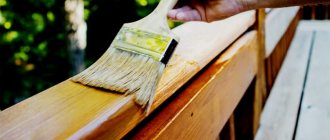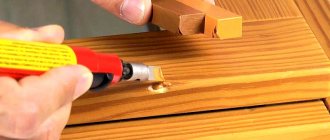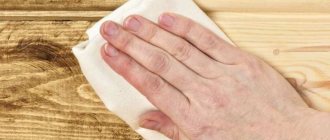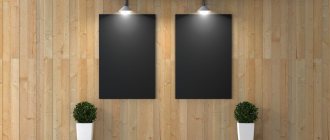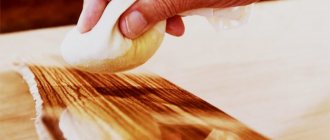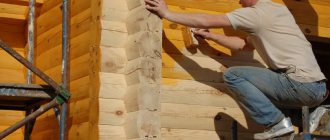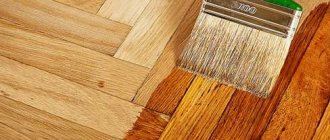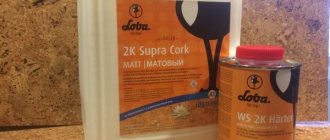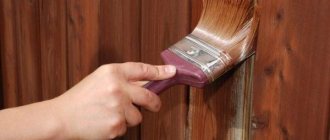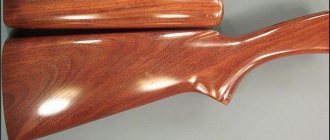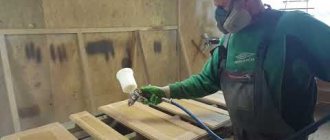There is no such information anywhere else! One day you varnished a wooden chair or painted the façade of your house with wood impregnation. Several years have passed, and the time has come to renew the applied coating - how to do this?
We tried to explain simply and clearly how to renew protective and decorative coatings for wood after a while. Can untreated wood be coated with oil, wax or stain? And if you are not well versed in wood products and have difficulty distinguishing stain from impregnation, read this article.
What to do with wood after oiling
One of the most effective methods for stabilizing wood is impregnation with oil compounds and waxing.
You can find a lot of specialized information about the types of oils and the technology for their application, but there is much less data on how to coat wood after oiling. This is partly due to the fact that after coating with oil-based protective compounds, the wood immediately takes on an excellent appearance and, in most cases, does not require additional actions.
Therefore, the entire post-processing cycle can be described in one phrase: re-grinding the coating after polymerization of the oil, the need for which arises quite rarely.
However, this case also has its own nuances, most of which are discussed in this review.
What does oiling wood do?
Just 20-30 years ago, most people associated a wooden house with a nondescript, dark gray structure and constant problems with the geometry of the log house.
Today, even a small bathhouse looks like a small masterpiece, captivating with the amber shade of the walls and the amazing texture of the wood pattern.
All this became possible thanks to the advent of wood protection technology based on oil impregnations, the widespread use of which made it possible to achieve the following goals:
- Slow down the aging process of wood several times.
- Achieve an original decorative effect without the usual problems of paint and varnish coatings.
- Implement an external water-repellent effect that significantly extends the life of a log or timber house.
- Restore old log houses with almost any degree of wear.
- Create a long-term antiseptic effect, including for the lower crowns of the log house, without disturbing the artistic concept of the house.
The physico-chemical principle of oil impregnation is simple: the ends and outer layer of logs or boards are impregnated with a hydrophobic composition - a mixture of special oils and additives that allow complete polymerization upon contact with oxygen and sunlight.
To be fair, it should be noted that the method of stabilizing wood using oil impregnations is far from new and has been successfully used in wooden architecture and shipbuilding for hundreds of years.
However, it is only now that compositions combining the optimal combination of operational and technological qualities and an affordable price have become available to the masses.
In addition, most oils for impregnation can be tinted in a wide range of colors and shades, so the treatment of wood with oils has long gone beyond the scope of protective coatings, and is gradually replacing traditional painting methods.
Types of varnishes and application
Today on the market and in hardware stores you can purchase a large number of different types of substances produced on all kinds of bases.
Main varieties:
- Oily.
- Resin.
- Alkyd.
- Alcohol.
- Epoxy.
- Acrylic.
- Polyester.
- Polyurethane.
Oily
Description: high absorption into the structure of the material, drying time - from 24 to 72 hours.
Purpose: practiced exclusively for interior work. Furniture and other wood items are covered. Not used for flooring.
Resin
Description: the composition may include natural amber, synthetic thermoplastic and thermosetting resins.
Purpose: used for similar work as oil ones.
Alkyd
Description: consists of alkyd mastics, petroleum products (white spirit, solvent), which accelerate the drying of driers. Increased moisture resistance and weather resistance. Complete drying time – up to 48 hours.
Purpose: processing of laminate, parquet, floating floors, designer furniture. The service life of the film on the floor covering is 2-3 years.
Alcohol-containing
Description: the preparation includes ethyl alcohol and resin diluted in it from 20 to 40%. Dries in 20 to 30 minutes.
Purpose: processing furniture, interior elements, musical instruments, glass and leather items. A specialized type, such as shellac, is used for decoupage.
Epoxy
Description: composition – two-component. Epoxy resin serves as a film former. Increased hardness, water resistance, shock resistance.
Purpose: processing of parquet, solid flooring, doors. To withstand high loads, they almost always acquire this type.
Acrylic
Description: diluted with ordinary water, odorless, harmless. Fire-resistant, water-resistant, steam-permeable. High-quality adhesion to wooden substrates.
Intended use: the product is used indoors. Mainly where there is an increased threat of fire or explosion. Rich properties allow you to coat even damp wood, as well as brick walls and concrete. We also recommend a review: how long does it take for a floor screed to dry after pouring, and how long does it take for the concrete to harden?
Polyester
Description: composition – multi-component, made on a polyester basis. The layer is thick, durable, colorless, glossy. The film is resistant to chemicals, water, and heat.
Purpose: Covers bases that require a thick, shiny film, protection from impact and abrasion (musical instruments, doors, furniture).
Polyurethane
Description: there are two-component (base with hardener) and three-component (base, hardener, solvent). High adhesion, diamond hardness. The smell is specific, pungent, persistent. The dried layer is reliably cleaned from water, chemicals, and corrosion. The period of complete hardening is up to 3 weeks.
Purpose: these products are applied to garden structures, external and internal foundations during the construction of houses, yachts, flooring.
NOTE! When purchasing a product, you need to take into account the characteristics and conditions in which the processed products and objects will be used in the future. Will they withstand sudden temperature changes, high humidity, and high loads? Also, be sure to pay attention to the smell - if interior work is planned.
In what cases is oil impregnation recommended?
At the moment, it is difficult to identify situations where oil treatment is the only solution. Any oiled surfaces could almost always be painted over.
However, in some cases, oil protection will be more effective and will allow you to achieve results that would not be possible with similar treatment with traditional paints and varnishes.
The lower crowns of the log house
The lower crowns of a log house are the Achilles heel of a wooden house, and their protection should be treated with maximum attention. Due to the vapor permeability of the coating, oil treatment in this case is the most preferable of all possible options.
The oil protective layer creates an optimal microclimate inside the logs, with minimal risk of developing fungal diseases.
Internal wall surfaces
Of all the existing types of painting of wooden buildings, impregnation with pure oils is the most environmentally friendly.
Considering that such processing also enhances the decorative effect, the use of oils for the interior decoration of wooden cottages has become a de facto standard in the modern architecture of houses made of timber and logs.
Surfaces with complex terrain
When designing the design of a house and outbuildings, it is necessary to consider not only the initial appearance of their coating, but also how this coating will be updated.
Obviously, boards decorated with carvings or profiled for technological reasons are extremely difficult to repaint if traditional paints and varnishes were originally used.
In this connection, oil impregnations are definitely more convenient for processing carved platbands, decking boards, steps and garden furniture.
Service life of wooden structures treated with impregnations and other means
The first question that worries everyone even at the stage of purchasing the first set of wood products is how long it will last.
It is practically impossible to answer this question unambiguously and accurately: service life always depends on strict adherence to the instructions. In addition, it is difficult to predict the operating conditions of your specific wooden structure.
Here it is necessary to explain where real, and not unfounded, guarantees of the durability of paint and varnish products come from. To be able to officially declare a certain period, the manufacturer must order an expensive and long-term study from an independent laboratory.
Laboratories are physically unable to reproduce the effects on treated wood of real atmospheric conditions, time and mechanical influences, so products are tested in so-called artificial aging chambers, where impacts are created even more severe on the product than would be the case under real conditions. Based on the research results, the manufacturer is issued a test certificate. For example, a test report issued by an independent laboratory confirms the durability of the Belinka Base + Toplasur complex for 10 years, but it is likely that such a coating will last even longer in real conditions.
However, durability research takes a long time. So you shouldn’t trust a brand that appeared on the market a year ago and claims a “25-year guarantee.”
What to do with wood after oil
The technology of coating wood with oil impregnations always involves preliminary grinding of the surface to be treated. This means that after polymerization of the protective composition there is no need for additional processing.
Moreover, some modifications of impregnations contain additives that form an outer protective layer, which is not recommended to be damaged.
However, in practice, additional treatment of coated surfaces is often carried out in the form of polishing with cloth cloths or special nozzles with low roughness.
In some cases - for example, when treating floors with oil and wax - it is necessary to polish the new coating.
Please note that there are two different approaches to creating an outer protective layer of wax:
- Separate coating after impregnation.
- Dissolving wax in the impregnating composition.
In modern conditions, the second option is most often used, since a large number of impregnations with pre-dissolved wax are available for sale.
Some manufacturers of oil impregnations include in their product range oils that can be subsequently painted with varnish or paint. In this case, the surface is first treated with a special primer and only then the finishing decorative coating is applied.
Can varnish be coated with varnish?
Over time, the varnish film becomes cloudy, wears out, and becomes covered with microcracks and scratches. Usually the owners decide to re-coat the interior detail with the substance. That's when you have to decide whether you can apply varnish over the varnish, or whether you will need to remove the old treatment first.
Let's say the old layer is so worn out and cracked that it spoils the appearance. According to experts, such a foundation requires complete replacement. If this is not done, attempts to update the item will remain unsuccessful. Chips, cracks, peeling areas will begin to stand out. Moreover, in some places the old emulsion will begin to swell when coated with a new composition (the effect of an unsuitable solvent will appear) and peel off from the base.
You will also need to remove the old composition if it has become cloudy, faded, or dull. This surface is first sanded using fine-grained sandpaper. And after that you can apply the product.
And yet, is it right to carry out such work? There is no consensus. Many experts are convinced that the previous coating should be completely removed. After all, you need to take into account such a factor as incompatibility of products. If the old and new compositions turn out to be incompatible, the subsequent layer will begin to peel off.
Other experienced craftsmen recommend not wasting energy on doing unnecessary work. And if you follow certain rules, after such preparatory measures it is quite possible to cover the previous layer with a new one.
IMPORTANT! If a water-based solution was used, then it is necessary to use the same type. Polymer mixtures and nitro varnishes can be renewed with various liquids, including water.
Should I turn to professionals?
Despite the apparent simplicity of the technology, in order to saturate wood with oil to create a high-quality and long-lasting coating, it is necessary not only to be fluent in the technology of applying oil, but also to know the features of the protective compounds used.
Since our company is the official supplier of the most famous brands of protective oils, all specialists directly involved in the work regularly attend advanced training courses, which guarantees full compliance of the coatings created with all working regulations.
accepts orders for repair or finishing treatment of wooden log houses and outbuildings, including oil painting and final sanding of coatings. You can clarify the details of cooperation and order a visit from a specialist to draw up an accurate work plan by contacting us by phone or by phone numbers published in the “Contacts” section.
Calculate the cost of painting and insulating your home right now
Select types of work:
Sandblasting Sanding with machines Warm seam Painting Additional. work
Select materials:
Ramsauer sealant Remmers sealant Gnature or Biofa oil Remmers oil Adler oil Other
